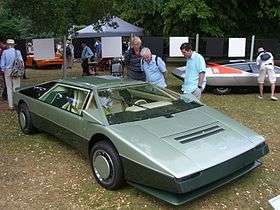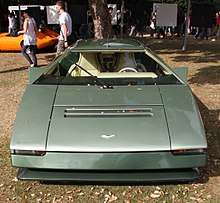Aston Martin Bulldog
The Aston Martin Bulldog, styled by William Towns, is a British, one-off concept vehicle produced by Aston Martin in 1979. The code name for the project was DP K901,[1], which was shortened to K9 after the famous Doctor Who robotic dog. Initially, a production run of 15–25 cars was planned but the project was deemed too costly and only one was built.
| Aston Martin Bulldog | |
|---|---|
 The Bulldog at the 2009 Goodwood Festival of Speed | |
| Overview | |
| Manufacturer | Aston Martin |
| Production | 1979 (1 produced) |
| Assembly | Newport Pagnell, Buckinghamshire, England |
| Designer | William Towns |
| Body and chassis | |
| Class | Sports car (S) |
| Body style | 2-door coupe |
| Layout | MR layout |
| Doors | Gullwing doors |
| Powertrain | |
| Engine | 5.3 L twin-turbocharged V8 |
| Dimensions | |
| Length | 4724 mm (186 in) |
| Height | 1092 mm (43 in) |
History
The Bulldog was designed to show off the capabilities of Aston Martin's new engineering facility in Newport Pagnell, as well as to chase after the title of fastest production car in the world. The car was officially launched on 27 March 1980 at the Bell Hotel at Aston Clinton. Although the car was built in the UK, it is left-hand-drive. The Bulldog's sharp wedge shape was designed by William Towns and features five centre-mounted, hidden headlamps, as well as gull-wing doors. Inside, the interior is upholstered in leather and uses multiple LED buttons like the Lagonda. Aston Martin planned to build 15-25 Bulldogs, but in 1981 Victor Gauntlett became chairman of Aston Martin and decided the project would be too costly, and the Bulldog project was shelved.[2] In 1984 Aston Martin sold the Bulldog to a middle eastern collector for £130,000 where the owner added both rear view mirrors and cameras. The Bulldog later was sold to an American collector and spent some time in the United States, but has recently been offered for sale in Britain. It was now green, compared to original exterior colours of silver and light grey. The interior has also been changed from the original dark brown and black to light tan.
Performance

The Bulldog is powered by a 5.3L V8 with twin Garrett turbochargers that produces 600 bhp (447 kW; 608 PS)(the engine was capable of 700 bhp (522 kW; 710 PS) on the test bed) and 500 lb⋅ft (678 N⋅m) maximum torque.[3] When it came out, Aston Martin claimed the car was capable of 237 mph (381 km/h), but the fastest speed the car was recorded doing was a verified 192 mph (307 km/h) during a test run at the MIRA track in late 1979.[4][1] Additionally, the wedge shaped design gave the Bulldog a drag coefficient of 0.34.[5]
References
- "Aston's 237mph one-off supercar". BBC Topgear. Retrieved 25 January 2015.
- Petrány, Máté. "The Bulldog Was Aston Martin's Mid-Engined Dream". Jalopnik. Archived from the original on 24 February 2018. Retrieved 23 February 2018.
- "A-Z Supercars: Aston Martin Bulldog". Evo. 6 February 2013. Retrieved 4 February 2015.
- "Concepts : 1980 Aston Martin Bulldog". AR Online. 12 June 2011. Archived from the original on 4 February 2015. Retrieved 4 February 2015.
- "In 1979, Aston Martin Built A Twin-Turbo Wedge That Could Reach 191MPH". Road & Track. 2 July 2016. Retrieved 23 February 2018.
External links
| Wikimedia Commons has media related to Aston Martin Bulldog. |
- Aston Martin Lagonda Ltd. – Official Company Site
- Aston Martin Picture Gallery – Bulldog